Diadems, Crowns
ANCIENT JEWELLERY EXHIBITED IN ANATOLIAN CIVILIZATIONS MUSEUM
Head Jewellery
Diadems, Crowns
Their first samples are made of gold, silver, or in small numbers bronze plates, in an oval shape with short sides round, and with a rosette motif in the middle. There are ones with repousse, dot or zigzag decorations. They are found in Alacahöyük and Troy in the 3rd thousand BC. It is spread in Cyprus at the mid of the 2 thousand BC (Enkomi grave finds). They are used as a vow or as the indicator of authority or as an ornamental piece for the gods and for the humans. On special life ocasions, in case of birth it has been used as the indicator of love, and also in feasts, disease, death and funeral.
A throne has been used as a rank and ornament in later periods. In accordance with Pliny, it was the symbol of god at the beginning. God sculptures, temples, holy places, animals to be sacrificed and even houses were crowned. The first samples of crowns were made of olive, oak and myrtle tree branches and leaves and then of metal.

| Name: | Diadem |
Type: | Gold |
Location where it came from:
| Muğla |
Way of Coming: | Not known |
Dimensions:: | L:33,1cm; W.:4,1cm. |
Weight: | 8.63 gr. |
Period: | The 4th century BC |
It has been cut in the form of a diadem from a golden sheet. There is a row of stylized egg series around it and a row of pearl series made of relief points on it. There are no intermediate leaves in the egg series and no scales in the pearl series. The surface of the diadem is covered with lotus and palmet flowers divided into groups by lines formed with small points. The technique used in the diadem is repoussé. In addition, ornaments similar to palmet leaves made of small points created by hitting on the upper side are seen on the front side in the mid part. There is a string passage hole on both ends.
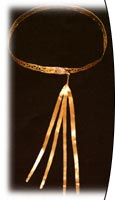
| Name: | Crown |
Type: | Gold |
Location where it came from: | Alacahöyük |
Way of Coming: | Excavation find |
Dimensions:: | L:53cm; W.:1.4cm. Fringe L:21 cm. |
Weight: | 40.82 gr. |
Period: | The Ancient Bronze Age |
It is attached by combining the two ends of a narrow band cut from a golden sheet and by twisting these ends with the ends of four simple, flat golden bands. The bands are used as fringe.
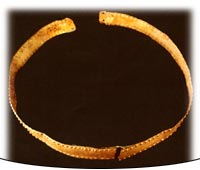
| Name: | Crown |
Type: | Gold |
Location where it came from: | Alacahöyük |
Way of Coming: | Excavation find |
Dimensions:: | Diameter:17 cm ; W.:2.2cm. |
Weight: | 25.06 gr. |
Period: | The Ancient Bronze Age |
The lower and upper edge of the band cut from a sheet made by hammering are ornamented with point relief, the ends are rounded and have two holes each. The big holes are opened from the internal to the external side and the small holes are opened from the external to the internal side. It is either riveted by overlapping the big holes or attached by being stitched to the cloth
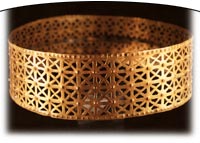
| Name: | Crown |
Type: | Gold |
Location where it came from: | Alacahöyük |
Way of Coming: | Excavation find 1936 |
Dimensions:: | D:19.2cm; W.:1.4cm. |
Weight: | 125.55 gr. |
Period: | The Ancient Bronze Age |
The wide part cut from a golden plate is combined by hammering in the form of a circle. Four bands one on the other are formed by placing the openwork rectangles, whose internal sides are diagonally divided, side by side. The corners of the rectangle and the lower and upper edge of the diadem are ornamented with relief points from one end to enother. It is made with hammering technique.
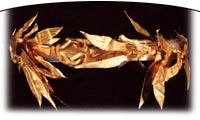
| Name: | Crown |
Type: | Gold |
Location where it came from: | Not known |
Way of Coming: | Not known |
Dimensions:: | L: 30.3 cm. |
Period: | The 3rd century BC |
It is placed on a wide, golden band so that the thin, golden leaves come across towards the middle. The Herakles node in the mid is made with relief. The veins on the leaves are also relief. The flat golden band part having the inventory number 5 - 1 - 65 is added to the back of the crown.
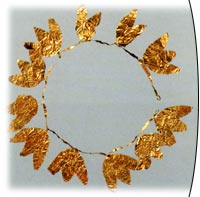
| Name: | Crown |
Type: | Gold |
Location where it came from: | Not known |
Way of Coming: | Confiscation |
Dimensions:: | L: 27 cm. |
Weight: | 6.11 gr. |
Period: | The 1st century BC |
It is formed with three - part leaves attached to eleven holes on a thin band with rings on its ends. It must be tied on the back side of the head with a golden string inserted in the rings. The fibers on the leaves are visible. One leaf is missing. There are crushes and breaks.
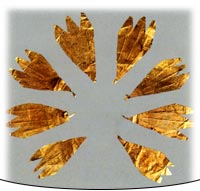
| Name: | Crown pieces (8pcs) |
Type: | Gold |
Location where it came from: | Milas |
Way of Coming: | Not known |
Dimensions:: | L:4-4.5 cm W:2-2.5 cm |
Weight: | 3.31 gr. |
Period: | The 2nd century AC |
Each leaf is cut from a golden sheet in the form of a lotus flower. The lotus flowers have three parts and the fiber lines are significant. The stems of the leaves are thin and are made in ring form to be attached to a flat golden band.